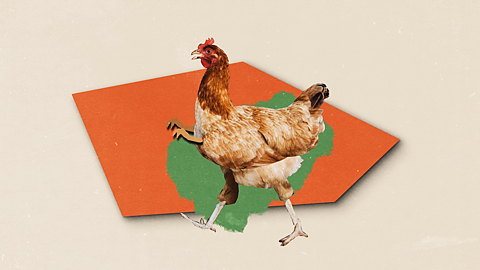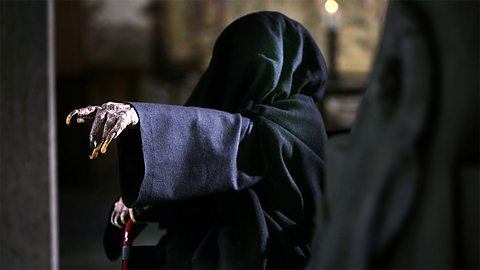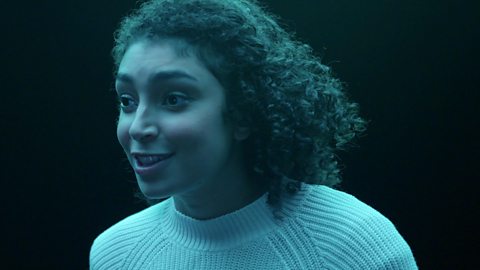Did you know?
Many of the names of literary devices come from Latin and Greek words.
- Simile comes from the Latin word similis meaning 'similar, like', while metaphor comes from the Greek word metapherein, 'to transfer'
- Allusion comes from the Latin verb alludere, meaning 'to refer to, to play with, or to joke'
- Hyperbole comes from the Greek meaning 'throw' (bole) 'beyond or above' (hyper)
Introduction
Literary devices are specific ways of using language or other literary elements that we can recognise and identify in a text (a piece of writing). These can work either at a word or sentence level or across the whole text.
Literary devices include language techniques, sometimes also knowns as linguistic or figurative devices. There are many language devices to use, including simile A comparison between two objects using âlikeâ or âasâ., metaphorMakes a direct comparison by presents one thing as if it were something else with the characteristic. For example describing a brave person as a lion., allusionA reference that is intended to make you think of a well-known thing or person. and hyperboleA way of speaking or writing that exaggerates for effect..
Writers choose these devices to influence the response of the reader, or to help communicate an idea or point of view. We can use our knowledge of literary devices to interpret or analyse not only what the writer is trying to say but also how they get their meaning across.
Once you understand how these techniques work, you can change the way you read - and write - for the better.
Video about using figurative devices
Learn how to use figurative devices effectively in your writing
Why use literary devices?
A well-chosen literary device can help make your writing more effective and powerful. They can be used in fiction or non-fiction texts, and can:
- add something special or original to your writing
- give more information using fewer words
- persuade or engage your reader
- communicate your ideas in a precise way
- help the reader visualise a scene
Language techniques are words or phrases that convey a meaning which is different to the literal one. For example, 'My love is like a red red rose' does not literally mean that their love is like an actual flower you can pick or grow. The speaker is trying to get across the idea that their love is beautiful - as well as other positive associations we might connect with a 'red red rose', like natural or intense.
Find the odd one out
Which of these does not use a literary device?
- The dogâs eyes were brown.
- The dogâs eyes were brown like melted chocolate.
- The dogâs melting chocolate eyes gazed into mine: it was love at first sight.
Answer 1.
The dogâs eyes were brown. It is a fact - it gives nothing more to the reader than basic information.

Making comparisons
Writers often make comparisons in their writing. There are a variety of ways to do this:
- Metaphor â a direct comparison, usually between two unlike things - 'His scars were a map on his skin'.
- Simile â a phrase that compares two different things by using a word such as 'like' or 'as' - 'His scars were like a map on his skin'.
- Personification - a type of metaphor where something non-human is given human characteristics - 'His scars called to me, screaming bravery and courage'.
- Analogy â a comparison often used to explain or clarify something, often the comparison is made to something different but familiar to the reader. You can use metaphors and similes when creating an analogy:
'The rainforests are the vital organs of our planet: they are the lungs that draw in carbon dioxide and breathe out oxygen; they are the kidneys because they regulate the flow and use of water; they are the heart of our natural world, pumping life into other ecosystems; they are essential to the health of our planet, by destroying the forest we are killing our planet.'
Analogy
An analogy, just like a simile and a metaphor, compares two things but the point of an analogy is not merely to show, but also to explain the relationship between the two things. Analogies will often be composed of multiple sentences or lines, rather than single phrases. They might include within them several similes or metaphors, or a combination of both.
In a famous speech about pollution and climate change, actor and politician, Arnold Schwarzenegger made this very powerful argument, using an analogy:
'There are two doors. Behind Door Number One is a completely sealed room, with a regular, gasoline-fuelled car. Behind Door Number Two is an identical, completely sealed room, with an electric car. Both engines are running full blast.
I want you to pick a door to open, and enter the room and shut the door behind you. You have to stay in the room you choose for one hour. You cannot turn off the engine. You do not get a gas mask.
Iâm guessing you chose Door Number Two, with the electric car, right? Door Number One is a fatal choice â who would ever want to breathe those fumes?
This is the choice the world is making right now.'
The listener would understand that Schwarzenegger is suggesting that not choosing clean energy (the option of Door Number Two) risks their health and the whole world.
Allusions
Allusions make reference to well-known characters, places or events that immediately create meaning in the mind of the reader. For example, a writer might refer to a male character as âa real Romeoâ. Many readers would know that this allusion is suggesting he is romantic, just like the famous character Romeo from William Shakespeareâs Romeo and Juliet.
Allusions link to a shared understanding of the world and are a useful way to communicate with the reader. However, you need to carefully choose your allusions so your readers are able to understand what youâre trying to say without too much work. For example, âHeâs a real Einsteinâ only works if you know that Albert Einstein was an extremely clever person.
Hyperbole
Hyperbole is using exaggeration for effect. These exaggerations are not true and are not meant to be taken literally. They are used to provoke strong emotions or emphasise a particular point:
- 'I can think of a million reasons why we need to talk about recycling.'
- 'She had to wait an eternity for him to return.'
- 'He was dying of embarrassment.'
Which of these is not hyperbole?
- 'Hydrogen is the oldest and most abundant element.'
The Extraordinary Elements by Colin Stuart - 'Iâm sadder than the weeping willow in Misery Park in Sadville.'
Small Town Hero by Patrick Neate - 'Heâs also an adrenaline junkie â think running down mountains, jumping off cliffs into the sea, and generally going through life with the energy of a neutron star.'
Diary of a Young Naturalist by Dara McAnulty
Answer: 1.
'Hydrogen is the oldest and most abundant element'. This is a fact not exaggeration.
Useful tips
A few carefully chosen devices are better than using a device in every sentence.
Match the device carefully to the reader. Think about who you are writing for and then select a device that is appealing and appropriate.
Remember that devices might not be suitable for some types of writing, such as scientific reports.
Donât be afraid to experiment with devices in your writing - play around and see what works. This may give you more confidence when reading - you are more likely to spot and understand why a device is being used by another writer.
Test your knowledge
Play Bitesize secondary games. gamePlay Bitesize secondary games
Have fun playing science, maths, history, geography and language games.

More on Fiction writing
Find out more by working through a topic
- count1 of 8

- count2 of 8

- count3 of 8

- count4 of 8
